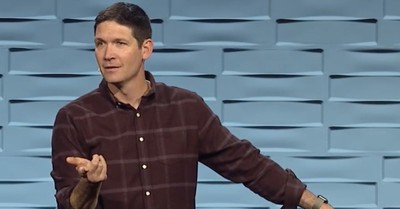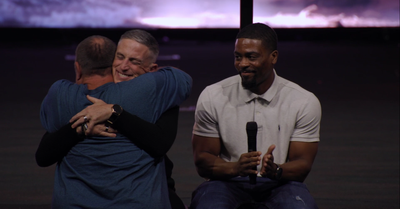
In September, the first prize at the annual Colorado State Fair art competition went to a submission entitled, “Théâtre D’opéra Spatial.” The painting was submitted by Jason Miller and depicts an ornate stage and costumed performers, washed in beautiful golden light. Miller, however, did not paint the image. Instead, he typed in a few prompts on a search bar, and an artificially intelligent art generator program, called Midjourney, did the rest.
When Allen won, outrage ensued, but Allen defended his decision to submit the painting he did not paint, arguing that his intent was not to deceive but to draw attention to the potential of artificial intelligence. “I won,” said Allen, “and I didn’t break any rules.”
This is another example of how artificial intelligence is raising questions about the nature and purpose of things, and how it relates to our humanity. What is “art” in a world where artificial intelligence can not only replicate nearly any image, but produce original images with superior skill and precision? Is art, at least as we’ve known it, finished now that the creative skills which once took a lifetime to master are reduced to a keystroke? What will now incentivize a promising young artist to develop these skills? Will painting become something pursued only by a few people as a leisure activity?
Because art is a way of expressing meaning, it has always been a uniquely human activity. After all, only humans seek meaning out of life, rather than just survival. In addition to the beauty and skill involved, we tend to value the pursuit of meaning we see in the creative work of others.
As Vincent van Gogh once reflected in a letter to his brother, I want to get to the point where people say of my work: that man feels deeply, that man feels keenly. Though I am often in the depths of misery, there is still calmness, pure harmony and music inside me. I see paintings or drawings in the poorest cottages, in the dirtiest comers. And my mind is driven towards these things with an irresistible momentum.
Art, then, is a way of seeking and communicating meaning. Even abstract art, such as Picasso’s Guernica or Piet Mondrian’s Composition II in Red, Blue, and Yellow, reflect the kind of meaning-seeking creatures we are. Though an exploding paint factory could produce a splattering of color that resembles a Jackson Pollock painting, the lack of intent, communication, and skill make all the difference.
It is along those three lines—what is said, how it is said, and why it is said—that art produced by AI is clearly different than that produced by people. A machine says something when it is asked to, communicating because it is told. Thus, when it comes to art generated by artificial intelligence, both what is said and why eventually points back to a person, the Jason Miller, so to speak, who submitted the request.
A bigger and more important conflict in the world of art, more than whether a piece is painted or printed, is whether meaning is constructed or discovered. If constructed, then the purpose of art is only the self-expression of both the producer and consumer. The artist is responsible only to create an “interpretive experience” and is not subject to any fixed realities outside of ourselves. If the world was created with meaning, however, then the task of the artist is to discover and to communicate, pointing to a meaning that is already there.
All that to say, the modern and postmodern devolution of art, which far predates AI and ranges from the bizarre to the vile, has far more to do with a culture-wide loss of meaning than the addition of this new technology. Undoubtedly, people will continue to use AI to generate images, but no matter how skillful or influential AI becomes, it will always be a tool, nothing more. It will have no idea why it’s doing what it’s doing.
Humans, however, will continue to think about the meaning of the universe and our place in it, and we will continue to make meaning when we can’t find it. That we are so self-reflective about meaning says a lot about the kind of world we live in and the kind of creatures we are. C.S. Lewis put it this way, “If the universe had no meaning, we should’ve never figured out that it had no meaning.”
That’s why the van Goghs will continue to amaze, and the grandmothers will continue to hang paintings from four-year-olds they know and love on their fridge. Ultimately, only people can be artists. Even the very best “art” from a machine is only a more sophisticated version of paint-by-numbers. To be human is to create, to invent, to innovate. To create art is how humans paraphrase creation, something we do because we are made in the image of the Creator.
This Breakpoint was co-authored by Kasey Leander. For more resources to live like a Christian in this cultural moment, go to colsoncenter.org.
Publication date: January 27, 2023
Photo courtesy: ©Yannis Papanastasopoulos/Unsplash
The views expressed in this commentary do not necessarily reflect those of CrosswalkHeadlines.
BreakPoint is a program of the Colson Center for Christian Worldview. BreakPoint commentaries offer incisive content people can't find anywhere else; content that cuts through the fog of relativism and the news cycle with truth and compassion. Founded by Chuck Colson (1931 – 2012) in 1991 as a daily radio broadcast, BreakPoint provides a Christian perspective on today's news and trends. Today, you can get it in written and a variety of audio formats: on the web, the radio, or your favorite podcast app on the go.
John Stonestreet is President of the Colson Center for Christian Worldview, and radio host of BreakPoint, a daily national radio program providing thought-provoking commentaries on current events and life issues from a biblical worldview. John holds degrees from Trinity Evangelical Divinity School (IL) and Bryan College (TN), and is the co-author of Making Sense of Your World: A Biblical Worldview.











